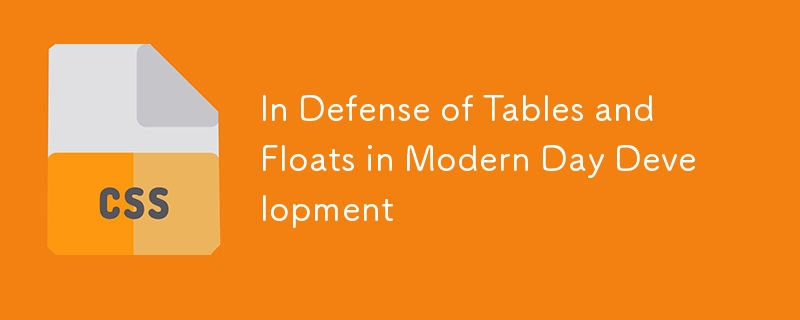In Defense of Tables and Floats in Modern Day Development

Two decades ago, HTML tables were the cornerstone of web page design. They provided developers with unprecedented control over page structure, enabling layouts beyond the simple top-to-bottom linearity. Columns could align both horizontally and vertically—a significant advancement at the time.
However, tables were never intended as a layout tool, and their misuse has led to numerous problems. This approach, while a convenient workaround, presents significant accessibility challenges in modern web development.
Nested <table>, <code><th>, <code><tr>, and <code><td> elements pose difficulties for screen readers, hindering accessibility compliance. Screen readers struggle to interpret deeply nested tables as coherent content blocks. This doesn't mean tables are inherently flawed; their limitations become apparent when used for anything beyond displaying tabular data. Consider a website layout built entirely with tables—it quickly becomes bloated and inaccessible.
<p>Despite their historical overuse and resulting negative reputation, tables serve a valuable purpose when used correctly. They excel at presenting semantically related data in a structured, linear format. Their utility remains relevant even today.</p>
<p>Here's an example of a table used appropriately: displaying <strong>tabular data</strong>! (Example omitted for brevity, but implied as per original text).</p>
<p>The early 2000s saw a shift towards web standards, favoring CSS floats over tables for layout. This separation of concerns—markup for structure, CSS for styling—resulted in cleaner, more maintainable code, and allowed a focus on accessibility and SEO.</p>
<p>(Example demonstrating the difference between table-based and float-based layouts omitted for brevity, but implied as per original text).</p>
<p>Floats, initially designed to allow text to wrap around images, have also faced criticism due to overuse. However, they remain relevant, particularly for the <code>shape-outside property. A valid use case for floats is wrapping text around a styled <div>.
<p>Modern CSS features like grid, flexbox, and multi-column layouts offer superior alternatives for page layout. These tools provide cleaner, more accessible code, and will likely remain the preferred approach for many years to come.</p>
<p>A flexbox example of the layout (omitted for brevity, but implied as per original text) demonstrates the simplicity and accessibility of modern layout techniques.</p>
<p>In conclusion, while tables and floats have earned a reputation for misuse, they remain valuable tools when applied correctly. Their proper usage ensures semantic clarity and accessibility. Modern layout techniques should be prioritized, but understanding the appropriate application of tables and floats remains essential for a well-rounded developer's toolkit.</p>
</div>
The above is the detailed content of In Defense of Tables and Floats in Modern Day Development. For more information, please follow other related articles on the PHP Chinese website!

Hot AI Tools

Undresser.AI Undress
AI-powered app for creating realistic nude photos

AI Clothes Remover
Online AI tool for removing clothes from photos.

Undress AI Tool
Undress images for free

Clothoff.io
AI clothes remover

Video Face Swap
Swap faces in any video effortlessly with our completely free AI face swap tool!

Hot Article

Hot Tools

Notepad++7.3.1
Easy-to-use and free code editor

SublimeText3 Chinese version
Chinese version, very easy to use

Zend Studio 13.0.1
Powerful PHP integrated development environment

Dreamweaver CS6
Visual web development tools

SublimeText3 Mac version
God-level code editing software (SublimeText3)

Hot Topics
 Vue 3
Apr 02, 2025 pm 06:32 PM
Vue 3
Apr 02, 2025 pm 06:32 PM
It's out! Congrats to the Vue team for getting it done, I know it was a massive effort and a long time coming. All new docs, as well.
 Building an Ethereum app using Redwood.js and Fauna
Mar 28, 2025 am 09:18 AM
Building an Ethereum app using Redwood.js and Fauna
Mar 28, 2025 am 09:18 AM
With the recent climb of Bitcoin’s price over 20k $USD, and to it recently breaking 30k, I thought it’s worth taking a deep dive back into creating Ethereum
 Can you get valid CSS property values from the browser?
Apr 02, 2025 pm 06:17 PM
Can you get valid CSS property values from the browser?
Apr 02, 2025 pm 06:17 PM
I had someone write in with this very legit question. Lea just blogged about how you can get valid CSS properties themselves from the browser. That's like this.
 Stacked Cards with Sticky Positioning and a Dash of Sass
Apr 03, 2025 am 10:30 AM
Stacked Cards with Sticky Positioning and a Dash of Sass
Apr 03, 2025 am 10:30 AM
The other day, I spotted this particularly lovely bit from Corey Ginnivan’s website where a collection of cards stack on top of one another as you scroll.
 A bit on ci/cd
Apr 02, 2025 pm 06:21 PM
A bit on ci/cd
Apr 02, 2025 pm 06:21 PM
I'd say "website" fits better than "mobile app" but I like this framing from Max Lynch:
 Comparing Browsers for Responsive Design
Apr 02, 2025 pm 06:25 PM
Comparing Browsers for Responsive Design
Apr 02, 2025 pm 06:25 PM
There are a number of these desktop apps where the goal is showing your site at different dimensions all at the same time. So you can, for example, be writing
 Using Markdown and Localization in the WordPress Block Editor
Apr 02, 2025 am 04:27 AM
Using Markdown and Localization in the WordPress Block Editor
Apr 02, 2025 am 04:27 AM
If we need to show documentation to the user directly in the WordPress editor, what is the best way to do it?
 Why are the purple slashed areas in the Flex layout mistakenly considered 'overflow space'?
Apr 05, 2025 pm 05:51 PM
Why are the purple slashed areas in the Flex layout mistakenly considered 'overflow space'?
Apr 05, 2025 pm 05:51 PM
Questions about purple slash areas in Flex layouts When using Flex layouts, you may encounter some confusing phenomena, such as in the developer tools (d...






